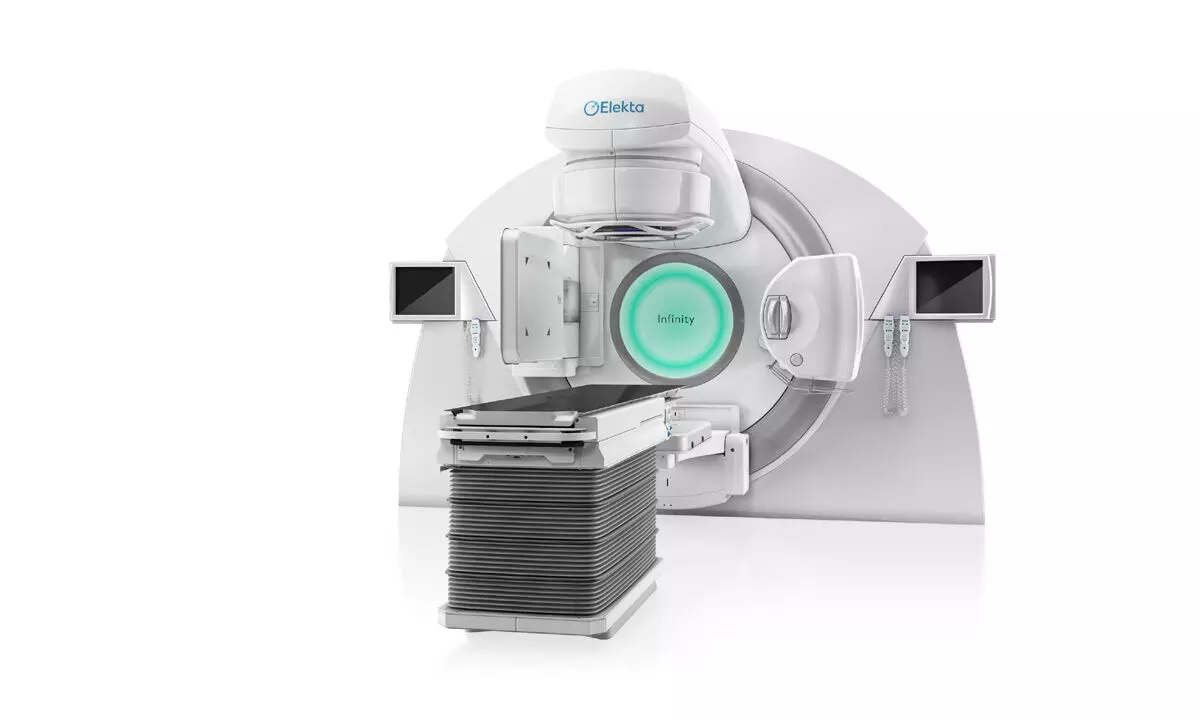Live
- Six pharma companies to set up their units in Telangana
- The Unstable Events of a 17-Wicket Day in Perth: India vs Australia
- Dutch FM's Israel trip cancelled after Netanyahu's arrest warrant
- UK to increase energy price cap by 1.2 per cent
- Ethiopia launches national coffee platform to maximise earnings
- Centre completes auction of 3 coal blocks, to yield annual revenue of Rs 2,710 crore
- Ullal Woman Files Complaint Against Husband Over Instant Talaq and Abuse
- Analysis: Russia's Nuclear-Capable Missile Marks Shift from Cold War Deterrence Doctrine
- OpenAI Plans In-House Browser "SearchGPT" to Compete with Google Chrome
- MP: Sanatan Hindu Ekta march gets support from BJP & Congress
Just In
The LinAc- ELEKTA INFINITY at SLG


The LinAc- ELEKTA INFINITY at SLG
Dr Khaleel Muzammil Ali Khan, Sr Consultant - Radiation Oncologist SLG Hospitals, Bachupally, talks about the treatment of head and neck cancer with radiation therapy
Treating head and neck cancer with radiation therapy Your doctor has prescribed radiation therapy to treat ENT cancer. This fact sheet describes this treatment and the precautions to be taken to ensure everything goes as smoothly as possible. ENT (ear, nose and throat) cancer includes several cancers located in the head or neck.
The most common are those of the tongue, throat, vocal cords, nose, and sinuses. What is radiation therapy? Radiation therapy is a treatment using radiation, i.e., high-energy x-rays, to destroy cancer cells in the diseased area and stop them from spreading and developing further. Radiation affects cancer cells AND the normal cells of the body through which it passes to reach tumours.
While most cancer cells are permanently destroyed, a large part of the normal cells repair themselves. What are the first visits for? Their purpose is to prepare you for the treatment and then to start it.
1st visit: making your mask Usually, a plastic mask is made that is exactly the same shape as your face and neck, to make treatments easier. The precise points where the radiation will be aimed are marked on the mask, so you won’t have any marks on your face. Making the mask is painless, and the material used is comfortable and easy to use. While the mask is being made, you will lie on your back with your neck on a special support.
2nd visit: planning scan (CT scan) During this visit, the medical team will examine the inside of your body using an imaging device called a scanner. This test is called computerized tomography, or CT scan. The team will use the scan to define precisely the area of your body that will be treated and to avoid touching areas that are not sick. This is called the “treatment plan”.
3rd visit: verification and first treatment first, the technologists will meet with you to discuss the steps of the treatment. Feel free to ask them any questions. In this third visit, they will make sure the area to be treated follows the treatment plan. You will have to take the position that you will be in for the treatments. You will be given the accessories you need to be able to maintain your position. Then you will receive your first treatment immediately. What happens during the treatment?
At each session, the technologists first ensure that everything is working as it should from a technical standpoint. After making sure you’re in the correct position, they leave the room. But an intercom and cameras keep you in touch with them. They can see and hear you, and you can talk to them. After your treatment, a technologist will give you the date and time of your next appointment. How long do the treatments take? Each session takes about 20 minutes. Usually you’ll receive treatments for 6 to 7 weeks. You’ll see your doctor regularly, who will ensure that the treatments run smoothly. Will I feel any pain? During the treatments, you won’t feel any pain.
However, you’ll probably have side effects during or after the treatments. What inconveniences and side effects should I be aware of? You’ll have to travel every day for your treatments. Try to organize things so that your daily life is not too disrupted. The main potential side effects are: – Swelling and rash in the mouth and throat, which can be painful. To ensure that you continue to eat properly, you’ll be followed by a nutritionist and a speech therapist (specialist in speech and swallowing). If it becomes difficult to swallow solids, eat purees and liquids.
In some cases, a small tube (nasogastric tube) may be used to feed you. This tube, inserted into the nose, goes directly to the stomach. This may be useful if you’re unable to swallow for a few weeks. Pain in the area being treated (if this happens, your doctor may prescribe a pain medication). – Changes in your ability to taste. – Decrease or thickening of your saliva. – Skin redness, similar to sunburn. – Fatigue. – Weight loss.
How should I prepare before my treatments? – Eat a healthy diet based on dieticians guide – You will also meet with a hospital dentist who will make sure your teeth are healthy. Sick teeth will have to be treated. Some could be removed to avoid the risk of infection during and after treatment. – If you haven’t already done so, stop smoking and drinking alcohol. The sooner the better.
([email protected], 7799235678)

© 2024 Hyderabad Media House Limited/The Hans India. All rights reserved. Powered by hocalwire.com






